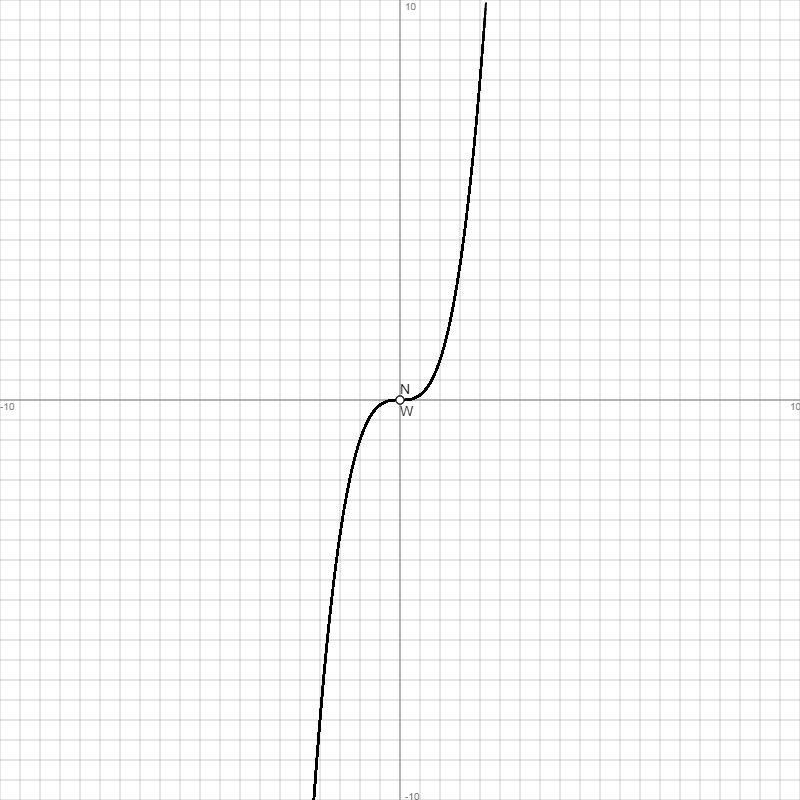
www.michael-buhlmann.de
Funktion: f(x) = x3, Df = R, Wf = R, Potenzfunktion 3. Grades, Funktion punktsymmetrisch zum Punkt O(0|0), x -> -∞: f(x) -> -∞, x -> +∞: f(x) -> +∞ ->
| Wertetabelle: | |||||
| x | f(x) | f'(x) | f''(x) | f'''(x) | Besondere Kurvenpunkte |
| -10 | -1000 | 300 | -60 | 6 | |
| -9.5 | -857.375 | 270.75 | -57 | 6 | |
| -9 | -729 | 243 | -54 | 6 | |
| -8.5 | -614.125 | 216.75 | -51 | 6 | |
| -8 | -512 | 192 | -48 | 6 | |
| -7.5 | -421.875 | 168.75 | -45 | 6 | |
| -7 | -343 | 147 | -42 | 6 | |
| -6.5 | -274.625 | 126.75 | -39 | 6 | |
| -6 | -216 | 108 | -36 | 6 | |
| -5.5 | -166.375 | 90.75 | -33 | 6 | |
| -5 | -125 | 75 | -30 | 6 | |
| -4.5 | -91.125 | 60.75 | -27 | 6 | |
| -4 | -64 | 48 | -24 | 6 | |
| -3.5 | -42.875 | 36.75 | -21 | 6 | |
| -3 | -27 | 27 | -18 | 6 | |
| -2.5 | -15.625 | 18.75 | -15 | 6 | |
| -2 | -8 | 12 | -12 | 6 | |
| -1.5 | -3.375 | 6.75 | -9 | 6 | |
| -1 | -1 | 3 | -6 | 6 | |
| -0.5 | -0.125 | 0.75 | -3 | 6 | |
| 0 | 0 | 0 | 0 | 6 | Nullstelle N(0|0) = Schnittpunkt Sy(0|0) = Wendepunkt W(0|0) = Sattelpunkt WS(0|0) |
| 0.5 | 0.125 | 0.75 | 3 | 6 | |
| 1 | 1 | 3 | 6 | 6 | |
| 1.5 | 3.375 | 6.75 | 9 | 6 | |
| 2 | 8 | 12 | 12 | 6 | |
| 2.5 | 15.625 | 18.75 | 15 | 6 | |
| 3 | 27 | 27 | 18 | 6 | |
| 3.5 | 42.875 | 36.75 | 21 | 6 | |
| 4 | 64 | 48 | 24 | 6 | |
| 4.5 | 91.125 | 60.75 | 27 | 6 | |
| 5 | 125 | 75 | 30 | 6 | |
| 5.5 | 166.375 | 90.75 | 33 | 6 | |
| 6 | 216 | 108 | 36 | 6 | |
| 6.5 | 274.625 | 126.75 | 39 | 6 | |
| 7 | 343 | 147 | 42 | 6 | |
| 7.5 | 421.875 | 168.75 | 45 | 6 | |
| 8 | 512 | 192 | 48 | 6 | |
| 8.5 | 614.125 | 216.75 | 51 | 6 | |
| 9 | 729 | 243 | 54 | 6 | |
| 9.5 | 857.375 | 270.75 | 57 | 6 | |
| 10 | 1000 | 300 | 60 | 6 | |
| Graph: | |||||
 | |||||
Abkürzungen: Df = (maximaler) Definitionsbereich, f(x) = Funktion, f'(x) = 1. Ableitung, f''(x) = 2. Ableitung, f'''(x) = 3. Ableitung, H = Hochpunkt, N = Nullstelle, P = Polstelle, R = reelle Zahlen, T = Tiefpunkt, W = Wendepunkt, WS = Sattelpunkt, Wf = Wertebereich, {.} = ein-/mehrelementige Menge, [.; .] = abgeschlossenes Intervall, (.; .) = offenes Intervall, [.; .), (.; .] = halboffenes Intervall, ∞ = unendlich.
Bearbeiter: Michael Buhlmann